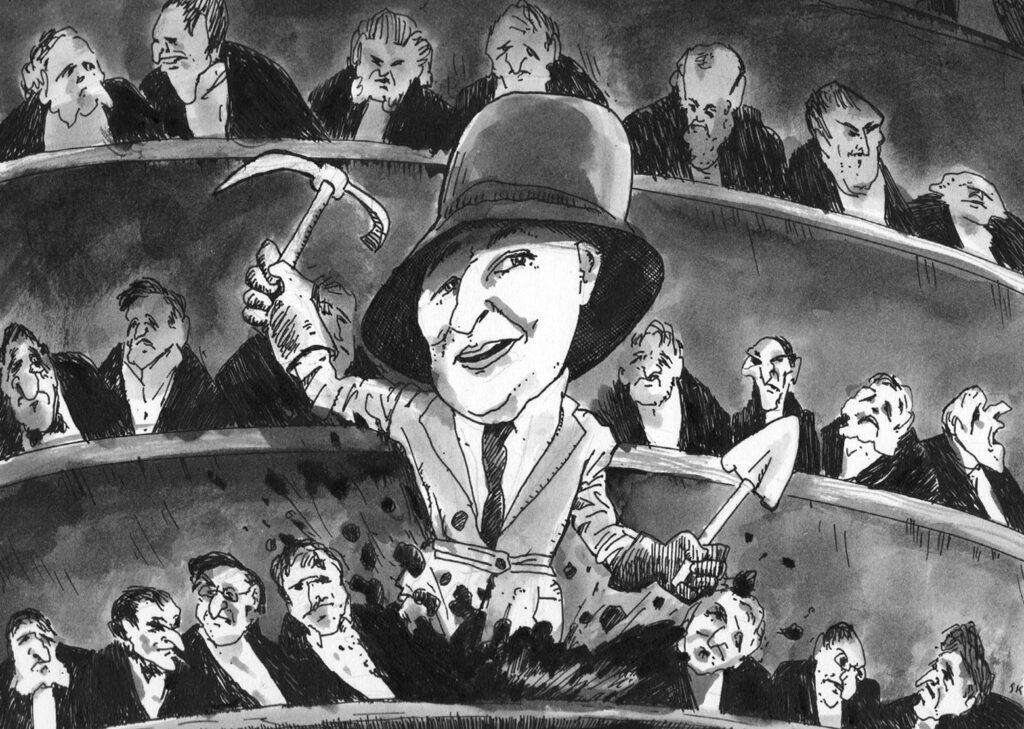The first woman elected to the Canadian House of Commons was Agnes Macphail. She served as a Progressive Party MP for Grey Southeast, in Ontario, from 1921 to 1935 and, after her riding was redistributed, as a United Farmers of Ontario MP for Grey-Bruce from 1935 to 1940. She championed rural issues, seniors’ pensions, workers’ rights, and, as famously detailed in a “Heritage Minute,” penal reform. She also sat in the Legislative Assembly of Ontario for the Co-operative Commonwealth Federation, worked as a journalist, and founded the Elizabeth Fry Society of Canada.
While many Canadians have at least some familiarity with Macphail and her pivotal role, the same probably cannot be said of our country’s second female MP, Martha Black. That’s unfortunate.

Martha Black forged her own path, from Chicago to Parliament and beyond.
Silas Kaufman
Black’s life was both fascinating and wildly unconventional for a woman of her time. She joined the Klondike gold rush, managed a sawmill, had an unexpected interlude in public service, developed an interest in conservation, and so much more. If there were a contest to honour historic lives well lived, hers would be in the running.
Enid Mallory’s Irrepressible: Yukon’s Martha Black — From Gold Rush to Parliament Hill is an in-depth examination of this political pioneer. Focusing on the period from 1898 to Black’s death on October 31, 1957, the book details how she bore witness to the growth of a young nation and the beauty and splendour of northern Canada. Black was the “unrivaled queen of all that host of men and women who sought the northern magic,” the Whitehorse Star noted in her obituary. “She, above all, caught and reflected the true spirit of the Yukon.”
Martha Munger was born on February 24, 1866, and grew up in Chicago, part of a prominent family. Her father, George, had lost some of his holdings during the Great Chicago Fire of 1871, but he had rebuilt his business empire and “owned 72 laundries in several cities, a sugar plantation in the West Indies, and a 2000-acre ranch in Kansas.” In 1887, Martha married her first husband, Will Purdy, whose father was an executive with the Chicago, Rock Island and Pacific Railroad. The newlyweds lived just outside of the city, in a house that Martha’s father bought for them. She started married life on a solid financial footing, “armed with an education in the fine arts of elocution, needlework, and watercolor and china painting.” She knew how to make lemon cream pie and how to type. The mother of two young boys, with a nanny at home, Martha had time to write poetry and helped out at the 1893 Chicago World’s Fair.
In spite of her seemingly charmed existence, Martha was disillusioned. She found life “monotonous,” according to Mallory. She loved her sons but viewed motherhood as restrictive — and she believed that her husband, who was away on business ten days every month, “was probably seeking excitement elsewhere.” The marriage dissolved when Will backed out of a planned expedition to the Klondike during the height of the gold rush. He was more interested in what a warmer climate, in the Sandwich Islands, could offer. But Martha believed her “path lay north,” where she envisioned “a fortune to claim for their two boys.” (She gave birth to a third son, Lyman, in the Klondike.) Martha and Will went their separate ways in 1903 and divorced the following year.
Martha’s trek to the Yukon was life changing. After tearfully convincing her brother, George, to take her there, she “felt herself falling in love with this vast and amazing land.” She hiked to Lake Bennett with George and her cousin Harry Peachy and climbed through the Chilkoot Pass like many prospectors before and after her. The “majestic scenery” of Canada’s North helped clear her once weary head. She learned to make sourdough bread and doughnuts, collected “new and exciting” varieties of plants, and roasted the blue grouse, ptarmigan, and fish that the men caught. She would always remember fondly those first weeks living in a cabin near lakes and mountains.
Martha met many people on her great adventure, including doctors, dentists, and lawyers who had come north with gold fever. Not long after her divorce, she discovered that a sawmill worker “was buying goods for himself and charging them to her,” and she sought some professional advice from George Black, a new lawyer in Dawson. “She found him helpful, knowledgeable and attractive,” Mallory writes. “Within two weeks he had asked her to marry him.”
Seven years her junior, George had grown up in New Brunswick, also in a prosperous family. He had been called to the bar in 1896, but he left his practice when he caught wind of the gold rush. After staking a claim north of Lake Laberge, he joined the Yukon bar in 1901 and became “the best criminal lawyer in Dawson.”
Martha’s second marriage was one more life-changing experience. She and her husband quickly became beloved members of their adopted community. They enjoyed nature and acquired some renown in local horticultural circles. They collaborated on a short book, Yukon Wild Flowers, with Martha providing the text. She also used her hobby, which she called “artistic botany,” to enter a flower competition, which she won. Her display of 464 varieties was later included at the 1909 World’s Fair in Seattle.
George became deeply interested and involved in Yukon politics. He was appointed territorial commissioner in 1912, and he and Martha moved into Government House, recently rebuilt after a devastating fire. Nine years later, George went to Ottawa as a Conservative member of Parliament; he won three more federal elections and became Speaker of the House in 1930.
Martha didn’t know much about Canada’s political system at first. “Immediately after my marriage, without compunction, I became an Anglican, an Imperialist and a Conservative,” she wrote in her memoirs. In other words, she followed in George’s footsteps in this area, though she certainly didn’t expect where that would take her.
In 1935, George, afflicted by “war trauma,” was admitted to a veterans’ hospital for six months. Mallory theorizes his post-traumatic stress could have resulted from his time crossing the Whitehorse Trail and Dead Horse Pass in 1898, the “serious complications” he experienced following an appendectomy in 1915, his battle wounds from fighting in the First World War, or the “pneumonia, broken ribs and possible internal injuries” he suffered while campaigning. Whatever the reason, he was physically unable to run in that fall’s federal election. Martha was asked to run in his place, as an Independent Conservative —“a political Conservative who lacked a formal affiliation to the party.”
When Martha sought advice from her father, he said, “Daughter, you have the gift of gab. You might possibly succeed.” With no radio stations in the territory, Martha had to reach would‑be voters in person. “This she did by steamer, motorboat, plane, car, teams of horses and on foot,” Mallory writes. “Once she walked several miles to contact three voters, who would have to walk eight miles to vote.” Although William Lyon Mackenzie King and the Liberals crushed R. B. Bennett and the Conservatives in one of the biggest political landslides in Canadian history, Martha Black won her seat. She didn’t realize that on election night, however. Her son Lyman had to call the Winnipeg Free Press the next day to ask who had carried the Yukon, and the response was “Oh, that other dame!”
Martha became the country’s second female MP and the first American-born woman to sit in the House of Commons. Parliament was draped in black when she arrived for opening day; King George V had recently died. When she rose to speak for the first time, it was to offer a “tribute of regret and sympathy to Queen Mary,” even though the Conservative whip, A. C. Casselman, had advised her against it. “She had expressed her sincere feelings,” Mallory writes, “but she had also let it be known that she was not just a pleasant face filling an empty chair.” Soon Martha was in “great demand” as a public speaker, especially on topics related to the Yukon, which she also discussed in articles for Chatelaine, The Province, The Canadian Home Journal, and other magazines. She served a single term, giving way to her husband, now much healthier, in 1940. Not wanting to “take George’s place” on Parliament Hill, she would continue forging her own path elsewhere.
Martha Black was a trailblazer, naturalist, adventurer, gadfly, and independent-minded politician. That makes her more than worthy of being mentioned in the same breath as Agnes Macphail, with whom she sat in the House of Commons.
Michael Taube is a columnist for the National Post, Loonie Politics, and Troy Media. Previously, he was a speech writer for Prime Minister Stephen Harper.

